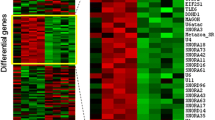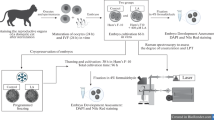Abstract
The high lipid content in porcine oocytes impairs in vitro embryo production (IVP). Here, we evaluated the influence of two different lipid modulators during in vitro maturation (IVM) on the embryo development and the lipid content of oocytes and embryos. In Experiment I, oocytes were exposed to 50 μM docosahexaenoic acid (DHA) with (+) or without (−) the presence of porcine follicular fluid (pFF). In Experiment II, phenazine ethosulfate (PES) was added during IVM at two concentrations (0.5 and 0.05 μM). The pFF- with 50 μM DHA treatment impaired nuclear maturation, cleavage and blastocyst rates (p < 0.05). Oocytes in pFF- media accumulated less lipids (p < 0.05). The addition of 0.5 μ M PES reduced all development rates (p < 0.05) and resulted in higher lipid content for oocytes and embryos. Only 0.05 μM PES oocytes matured similarly to the control (p > 0.05), although embryo development and embryo lipid content was similar to 0.5 μM PES oocytes (p > 0.05). Thus, 50 μM DHA supplementation in the IVM medium without pFF impaired oocyte maturation and embryo development rates without interfering in oocyte lipid content even in the presence of pFF. Maturation with PES neither favored porcine embryo development nor reduced their lipid content.



Similar content being viewed by others
Data availability
The datasets in this study are available from the corresponding author on reasonable request. All data and materials are available for publication.
References
Amstislavsky S, Mokrousova V, Brusentsev E et al (2018) Influence of cellular lipids on cryopreservation of mammalian oocytes and preimplantation embryos: a review. Biopreserv Biobank. https://doi.org/10.1089/bio.2018.0039
Barber E, Sinclair AJ, Cameron-Smith D (2013) Comparative actions of omega-3 fatty acids on in-vitro lipid droplet formation. Prostaglandins Leukot Essent Fat Acids 89:359–366. https://doi.org/10.1016/j.plefa.2013.07.006
Barceló-Fimbres M, Seidel GE (2011) Cross-validation of techniques for measuring lipid content of bovine oocytes and blastocysts. Theriogenology 75:434–444. https://doi.org/10.1016/j.theriogenology.2010.09.007
Braga JV, Komninou ER, Vieira AD, Mondadori RG (2019) Approaches to reduce lipids : a review of its impacts on in vitro embryo production. Rev Bras Reprodução Anim:3–7
Brasaemle DL, Wolins NE (2012) Packaging of fat: an evolving model of lipid droplet assembly and expansion. J Biol Chem 287:2273–2279. https://doi.org/10.1074/jbc.R111.309088
Brevini TAL, Vassena R, Francisci C, Gandolfi F (2005) Role of adenosine triphosphate, active mitochondria, and microtubules in the acquisition of developmental competence of parthenogenetically activated pig oocytes. Biol Reprod 72:1218–1223. https://doi.org/10.1095/biolreprod.104.038141
Che L, Lalonde A, Bordignon V (2007) Chemical activation of parthenogenetic and nuclear transfer porcine oocytes using ionomycin and strontium chloride. Theriogenology 67:1297–1304. https://doi.org/10.1016/j.theriogenology.2007.02.006
Correia PA (2019) Etossulfato de fenazina na maturação in vitro de oócitos bovinos. Diss (Mestrado em Zootec - Univ Fed Lavras 82
De La Torre-Sanchez JF, Preis K, Seidel GE (2006) Metabolic regulation of in-vitro-produced bovine embryos. I. Effects of metabolic regulators at different glucose concentrations with embryos produced by semen from different bulls. Reprod Fertil Dev 18:585–596. https://doi.org/10.1071/RD05063
de Macedo MP, Glanzner WG, Rissi VB et al (2019) A fast and reliable protocol for activation of porcine oocytes. Theriogenology 123:22–29. https://doi.org/10.1016/j.theriogenology.2018.09.021
Downs SM, Humpherson PG, Leese HJ (1998) Meiotic induction in cumulus cell-enclosed mouse oocytes: involvement of the pentose phosphate Pathway1. Biol Reprod 58:1084–1094. https://doi.org/10.1095/biolreprod58.4.1084
Dunning KR, Russell DL, Robker RL (2014) Lipids and oocyte developmental competence: the role of fatty acids and β-oxidation. Reproduction 148. https://doi.org/10.1530/REP-13-0251
Elis S, Oseikria M, Vitorino Carvalho A et al (2017) Docosahexaenoic acid mechanisms of action on the bovine oocyte-cumulus complex. J Ovarian Res 10:1–14. https://doi.org/10.1186/s13048-017-0370-z
Fitzpatrick M (2014) Measuring cell fluorescence using ImageJ
Gajda B (2009) Factors and methods of pig oocyte and embryo quality improvement and their application in reproductive biotechnology. Reprod Biol 9:97–112. https://doi.org/10.1016/S1642-431X(12)60020-5
Gajda B, Bryla M, Smorag Z (2008) Effects of protein source, vitamin E and Phenazine Ethosulfate on developmental competence and quality of porcine embryos cultured in vitro. Folia Biol (Praha) 56:57–63. https://doi.org/10.3409/fb56
Gajda B, Romek M, Grad I et al (2011) Lipid content and cryotolerance of porcine embryos cultured with phenazine ethosulfate. Cryo-Letters 32:349–357. https://doi.org/10.1071/RDv23n1Ab73
Genicot G, Leroy JLMR, Van Soom A, Donnay I (2005) The use of a fluorescent dye, Nile red, to evaluate the lipid content of single mammalian oocytes. Theriogenology 63:1181–1194. https://doi.org/10.1016/j.theriogenology.2004.06.006
Hoyos-Marulanda V, Alves BS, Rosa PRA et al (2019) Effects of polyunsaturated fatty acids on the development of pig oocytes in vitro following parthenogenetic activation and on the lipid content of oocytes and embryos. Anim Reprod Sci 205:150–155. https://doi.org/10.1016/j.anireprosci.2019.05.003
Hwang IS, Kim SW, Byun SJ et al (2012) The effect of horse serum on in vitro development of porcine parthenogenetic embryos. Reprod Biol 12:25–39. https://doi.org/10.1016/S1642-431X(12)60075-8
Jump DB (2009) N-3 polyunsaturated fatty acid regulation of hepatic gene transcription. Curr Opin Lipidol 19:242–247. https://doi.org/10.1097/MOL.0b013e3282ffaf6a.N-3
Khajeh M, Rahbarghazi R, Nouri M, Darabi M (2017) Potential role of polyunsaturated fatty acids, with particular regard to the signaling pathways of arachidonic acid and its derivatives in the process of maturation of the oocytes: contemporary review. Biomed Pharmacother 94:458–467. https://doi.org/10.1016/j.biopha.2017.07.140
Krisher RL, Brad AM, Herrick JR et al (2007) A comparative analysis of metabolism and viability in porcine oocytes during in vitro maturation. Anim Reprod Sci 98:72–96. https://doi.org/10.1016/j.anireprosci.2006.10.006
Moreira F, Moore K, Hansen PJ (2001) Protocol to Count Cell Number of Preimplantation Embryos using Nuclear Staining with Hoechst 33342 or DAPI Preparation of DAPI Embryo stained with Hoechst 33342 . What to Do When There are Too Many Cells to Count. 3–4
Nascimento AB, Albornoz MS, Che L et al (2010) Synergistic effect of porcine follicular fluid and dibutyryl cyclic adenosine monophosphate on development of parthenogenetically activated oocytes from pre-pubertal gilts. Reprod Domest Anim 45:851–859. https://doi.org/10.1111/j.1439-0531.2009.01368.x
Oseikria M, Elis S, Maillard V et al (2016) N-3 polyunsaturated fatty acid DHA during IVM affected oocyte developmental competence in cattle. Theriogenology 85:1625–1634.e2. https://doi.org/10.1016/j.theriogenology.2016.01.019
Paczkowski M, Schoolcraft WB, Krisher RL (2014) Fatty acid metabolism during maturation affects glucose uptake and is essential to oocyte competence. Reproduction 148:429–439. https://doi.org/10.1530/REP-14-0015
Paulini F, Silva RC, De Paula Rôlo JLJ, Lucci CM (2014) Ultrastructural changes in oocytes during folliculogenesis in domestic mammals. J Ovarian Res 7:1–12. https://doi.org/10.1186/s13048-014-0102-6
Pawlak P, Warzych E, Cieslak A et al (2018) The consequences of porcine IVM medium supplementation with follicular fluid become reflected in embryo quality, yield and gene expression patterns. Sci Rep 8:1–12. https://doi.org/10.1038/s41598-018-33550-4
Prates EG, Nunes JT, Pereira RM (2014) A role of lipid metabolism during cumulus-oocyte complex maturation: impact of lipid modulators to improve embryo production. Mediat Inflamm 2014. https://doi.org/10.1155/2014/692067
Romek M, Kepczynski M, Gajda B (2011) Lipid content in pig blastocysts cultured in the presence or absence of protein and vitamin E or Phenazine Ethosulfate. Folia Biol (Praha) 59:25–30. https://doi.org/10.3409/fb59
Sanchez-Lazo L, Brisard D, Elis S et al (2014) Fatty acid synthesis and oxidation in cumulus cells support oocyte maturation in bovine. Mol Endocrinol 28:1502–1521. https://doi.org/10.1210/me.2014-1049
Sturmey RG, Leese HJ (2003) Energy metabolism in pig oocytes and early embryos. Reproduction 126:197–204. https://doi.org/10.1530/rep.0.1260197
Sudano MJ, Paschoal DM, da Silva RT et al (2011) Lipid content and apoptosis of in vitro-produced bovine embryos as determinants of susceptibility to vitrification. Theriogenology 75:1211–1220. https://doi.org/10.1016/j.theriogenology.2010.11.033
Suzuki K, Takahashi K, Nishimaki-Mogami T, et al (2009) DHA induces adipose differentiation relaated protein through activation of .pdf. 32:1177–1182
Uhm SJ, Gupta MK, Kim T, Lee HT (2007) Expression of enhanced green fluorescent protein in porcine- and bovine-cloned embryos following interspecies somatic cell nuclear transfer of fibroblasts transfected by retrovirus vector. Mol Reprod Dev 74:1538–1547. https://doi.org/10.1002/mrd.20755
Walther T, Farese R Jr (2012) Lipid droplets and cellular lipid metabolism. Annu Rev ofBiochemistry 81:687–714. https://doi.org/10.1146/annurev-biochem-061009-102430
Warzych E, Pawlak P, Pszczola M et al (2017) Interactions of bovine oocytes with follicular elements with respect to lipid metabolism. Anim Sci J 88:1491–1497. https://doi.org/10.1111/asj.12799
Welte MA, Gould AP (2017) Lipid droplet functions beyond energy storage. Biochim Biophys Acta - Mol Cell Biol Lipids 1862:1260–1272. https://doi.org/10.1016/j.bbalip.2017.07.006
Yoshioka K, Suzuki C, Tanaka A et al (2002) Birth of piglets derived from porcine zygotes cultured in a chemically defined Medium1. Biol Reprod 66:112–119. https://doi.org/10.1095/biolreprod66.1.112
Acknowledgments
The authors thank to Conselho Nacional de Desenvolvimento Científico e Tecnológico (CNPq), Fundação de Amparo a Pesquisa do Rio Grande do Sul (FAPERGS) and Coordenação de Aperfeiçoamento de Pessoal de Nível Superior (CAPES) (Finance Code 001), which jointly financed this study, to Laboratórios Microvet for the financial support given to the first author and to Frigorífico Castro (Pelotas-RS) for allowing the collection of the ovaries used in this study.
Author information
Authors and Affiliations
Contributions
José Victor Cardoso Braga – Investigation, data curation, visualization and writing – original draft; Andrez Pastorello Bohn – Investigation; Luana Pescke Soares – Investigation; Eliza Rossi Komninou - Data curation, investigation, resources, writing – original draft; Thomaz Lucia Júnior – Formal analysis, funding acquisition, resources, writing – review & editing; Arnaldo Diniz Vieira – Conceptualization, methodology, resources, supervision, validation, writing – review & editing; Rafael Gianella Mondadori – Conceptualization, funding acquisition, methodology, project administration, resources, supervision, validation, writing – review & editing.
Corresponding author
Ethics declarations
Ethics approval
The ovaries were collected in a slaughterhouse inspected by the Federal Inspection Service from the Ministry of Agriculture, Livestock and Supply, where all humanitarian slaughter regulations are followed and inspected. As the experiments does not involve animal models, the institution does not require approval by the Ethics and Animal Experimentation Committee.
Consent to participate
All authors read and approved the manuscript.
Consent to publish
All authors read and approved the manuscript.
Competing interests
The authors declare no conflicts of interest.
Additional information
Publisher’s note
Springer Nature remains neutral with regard to jurisdictional claims in published maps and institutional affiliations.
Rights and permissions
About this article
Cite this article
Braga, J.V.C., Bohn, A.P., Soares, L.P. et al. Docosahexaenoic acid and phenazine ethosulfate are not efficient lipid modulators for porcine in vitro maturation systems. Vet Res Commun 46, 731–738 (2022). https://doi.org/10.1007/s11259-022-09889-5
Received:
Accepted:
Published:
Issue Date:
DOI: https://doi.org/10.1007/s11259-022-09889-5




